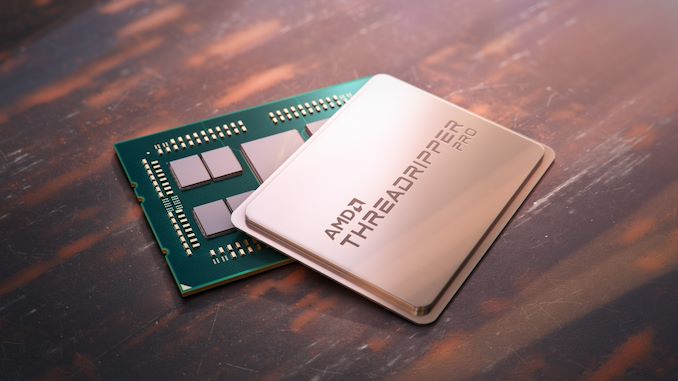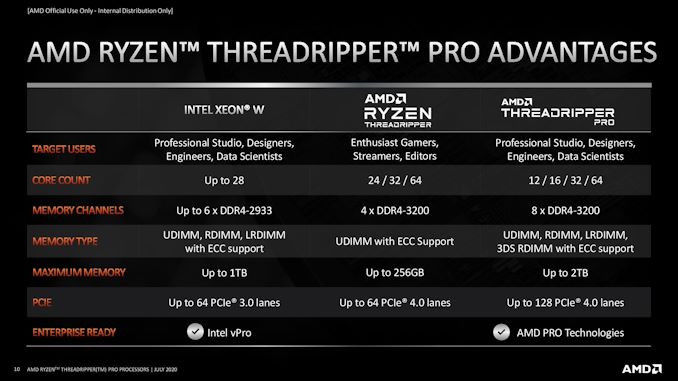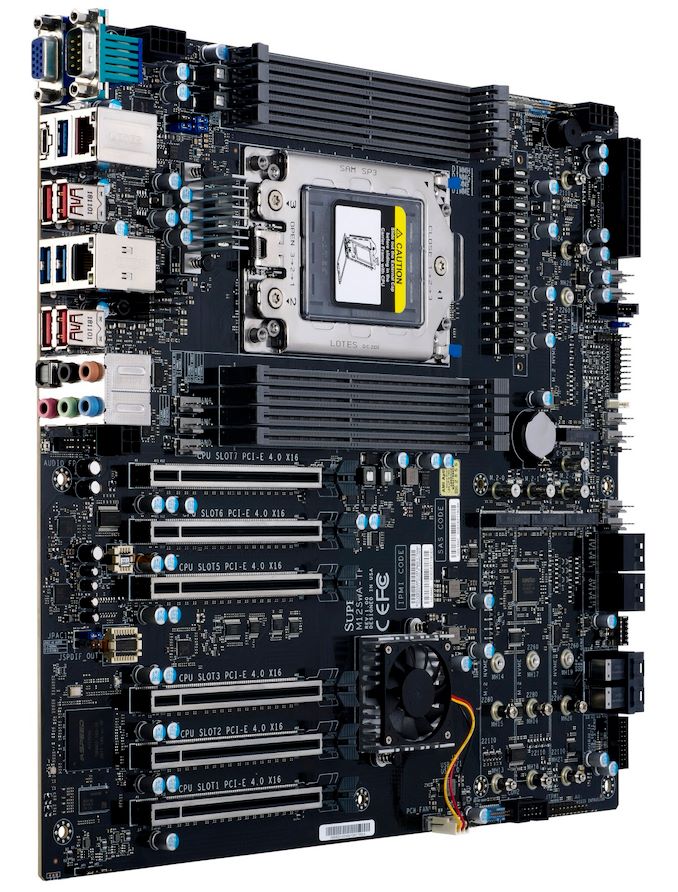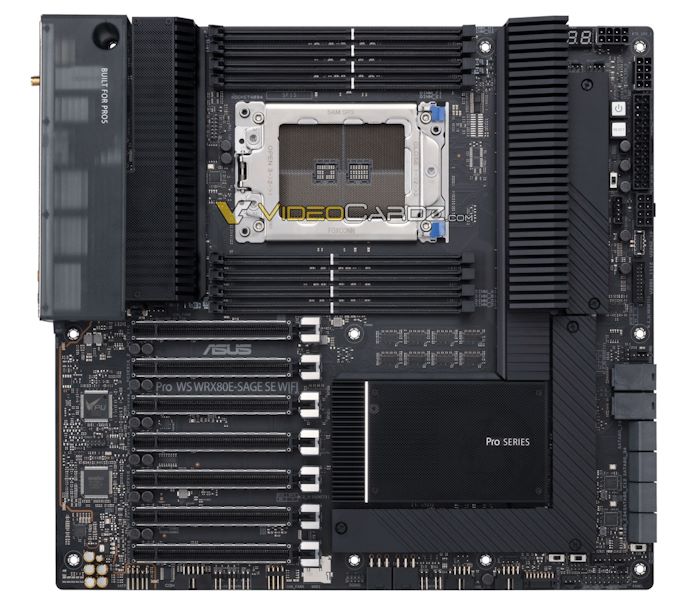AMD Opens Up Threadripper Pro: Three New WRX80 Motherboards
by Gavin Bonshor on January 12, 2021 12:15 PM EST
Stepping out of its supposed 'exclusivity deal' with Lenovo, who had the first rights to Threadripper Pro in the ThinkStation P620, motherboard vendors have started showing off some of its WRX80 motherboard models designed for AMD's Ryzen Threadripper Pro processors. Some of the benefits of the new platform over standard Threadripper include eight-channel memory and up to 128 x PCIe 4.0 lanes, which is double that of the non-Pro variants. While this sounds like EPYC, it sits between the two with only 2 TB DRAM support. It's time to showcase what we know, including three new models based on the WRX80 chipset.
The AMD WRX80 chipset benefits from eight-channel memory for increased bandwidth when compared to quad-channel Threadrippers and dual-channel Ryzen configurations, with capacity for up to 2 TB when used with DDR4 LRDIMM memory. It also includes support for both ECC and non-ECC memory at DDR4-3200. The biggest jump in regards to specification compared to regular TR is in its PCIe support, with up to 128 PCIe 4.0 lanes available, which in turn increases the amount of PCIe slot real estate vendors can use.
Patrick Kennedy from ServeTheHome has affectionately called this platform 'WEPYC', as in 'Workstation EPYC', as it is more like an EPYC than it is a Threadripper.
Supermicro M12SWA-TF
The Supermicro M12SWA-TF is dominated by its transposed sWRX8 socket (LGA 4094) and includes eight horizontal memory slots, with support for up to 1 TB of DDR4-3200. The Supermicro has support for AMD Ryzen Threadripper Pro processors up to 64 cores, including the entry-level 16 core variant. It is using an all-black PCB, with a cooling fan attached to the heatsink, with HEDT chipsets having a tendency to run quite warm. This will be even more apparent with PCIe 4.0 lanes over passively cooled options that use PCIe 3.0.
It is E-ATX in size, which is fully utilized with an impressive six full-length PCIe 4.0 x16 slots. This includes support for two triple-slot or three dual-slot graphics cards, which will depend on the configuration a user opts for. For storage, the M12SWA-TF includes four SATA ports and four PCIe 4.0 x4 M.2 slots that include support for RAID 0, 1, 5, and 10 arrays. Supermicro has also incorporated two PCIe 4.0 U.2 slots, with support for just RAID 0 and 1 arrays. The M12SWA-TF also uses an ASpeed's 7th generation AST2600 BMC controller with one D-sub video output on the rear for physical IPMI access. (Ian: Oooh, AST2600 is new, isn't it?)
The board also includes support for up to five USB 3.2 G2 ports, with four Type-A and one Type-C, and five USB 3.2 G1 Type-A ports including a mixture of support on the rear panel and through internal headers. There's also two USB 2.0 ports available, with ten 4-pin fan headers, including two for CPU fans and eight for chassis fans. Supermicro is using Realtek's new and unannounced ALC4050 HD audio codec, with a secondary ALC1220 codec. Networking support includes two RJ45 ports, including one powered by an Aquantia AQC113C 10 GbE controller, with an Intel I120-AT Gigabit controller also allowing for IPMI access.
ASUS WRX80 Pro WS Sage SE WIFI
Another model expected for AMD's Ryzen Threadripper Pro is the ASUS WRX80 Pro Sage SE WIFI. While we don't have any technical information and specifications from ASUS itself, we do have an image of it that VideoCardz reported on. There's a lot to go on from just the image, and it looks as though ASUS will fully utilize all of the PCIe 4.0 lanes from Threadripper Pro.
The ASUS WRX80 Pro WS Sage SE WIFI is using seven full-length PCIe 4.0 x16 slots, with eight memory slots in two banks of four flanking the transposed LGA 4094 socket. The design includes an all-black PCB, with contrasting black heatsinks for the chipset, M.2 slots, and power delivery. The memory will operate at 1PDC, with eight slots likely to offer similar memory support to Supermicro's M12SWA-TF model, although we will find out more when ASUS officially unveils it.
We do know that the WRX80 Pro will include Wi-Fi capabilities, most likely using one of Intel's Wi-Fi 6 interfaces. From the design, it looks like it will include eight SATA, three PCIe 4.0 x4 M.2, and two PCIe 4.0 x4 U.2 ports for storage, but hopefully, ASUS will shed more light on the official specifications soon.
GIGABYTE WRX80 SU8
Based upon a leak from VideoCardz, GIGABYTE is also joining the fray with its WRX80 SU8 model. As it stands, we don't have official specifications or any details from GIGABYTE itself, it looks to be using a large PCB, likely EEB form factor from what we can see. Like the other WRX80 models, the GIGABYTE includes eight memory slots for eight-channel memory, with ECC and non-ECC types supported. The slots are split into two pairs of four and are horizontally aligned which surrounds the transposed LGA 4094 socket.
The GIGABYTE WRX80 SU8 includes seven full-length PCIe 4.0 x16 slots, with a large chipset heatsink on the right-hand side. While it's difficult to determine a lot of the storage specifications from the image we have from VideoCardz, we can see it may include three to four Ethernet ports on the rear panel.
Overall
In speaking with one of the vendors, their main market is going to be system integrators - people who build and sell workstations. I contacted a high-end system integrator and confirmed that they are building a TR Pro machine, although it is very much still a work in process. The vendor, when asked about on-shelf availability, said that they don't particularly plan on doing a full retail packaging, but should AMD push the TR Pro CPUs into the consumer channel, they will prepare the appropriate boxing. In that light, as it stands, it looks like it will depend on AMD to decide if they want to enable the regular consumer retail channel.
At this time, we don't have any information on pricing or when the aforementioned WRX80 models for AMD's Ryzen Threadripper Pro will be launched.
Interested in more of the latest industry news? Check out our CES 2021 trade show landing page!














27 Comments
View All Comments
Unashamed_unoriginal_username_x86 - Tuesday, January 12, 2021 - link
It's interesting to see U.2 making more inroads to workstation, and the ASUS board looks even better then those monochrome NZXT boards, great symmetry up top.Silver5urfer - Tuesday, January 12, 2021 - link
It's insanely expensive and they can't even get a damn passive cooled PCH on these ? Insane.ZeDestructor - Tuesday, January 12, 2021 - link
I'm more salty there's a chipset at alllmcd - Tuesday, January 12, 2021 - link
You really think that amount of IO fits onto a sanely-sized package with no PCH? Honestly go away, this isn't for you.Athlex - Tuesday, January 12, 2021 - link
Sure it makes sense. Take a look at the Asrock Rack ROMED8-2T. Roughly the same I/O and board size but no chipset with everything running off the SoC. I would have assumed the same if the TR Pro is EPYC-based.ZeDestructor - Wednesday, January 13, 2021 - link
Yes cause it does? About the only thing the chipset actually adds is more PCIe lanes remapped to USB, something that a couple of PCIe-based USB controller would do just fine off 1 or 2 lanes of PCIe that the chipset currently uses.On Zen2/3, essentially all the IO lives on the IOD, 32 and 128 PCIe/USB/SATA for AM4 and SP3 IODs respectively, even though AMD are right dicks in locking it away with an undersized AM4 socket and.. well.. everything about TRX40.
PixyMisa - Wednesday, January 13, 2021 - link
Threadripper Pro has 128 lanes of PCIe 4.0.Samus - Thursday, January 14, 2021 - link
I was thinking the same. They probably “could” but with that many PCIe4 lanes...I’d they are all filled up the TDP of that chipset is going to be pegged which is like what 15w or something on the X570 so this is probably even higher.ZoZo - Tuesday, January 12, 2021 - link
There are actually at least 3 other pictures that can be found for the Asus board:https://quasarzone.com/bbs/qn_hardware/views/80524...
Judging by the lack of VGA port, it seems to be the only one out of the 3 to not have an onboard BMC. Unless there's a separate bracket for it, but that would mean sacrificing one of those potentially precious PCI-E x16 slots.
HappyCracker - Wednesday, January 13, 2021 - link
There is a Nuvoton chip visible on the board. It *could* be the BMC. Additionally, they could share the onboard NICs to provide an IP just for the BMC. Lastly, while there is no VGA port, it may be just a small bracket to provide that. The one connector underneath the PCIe slot could be for that. My current desktop board (Asus Z10PE D16-WS) runs in a similar fashion. I agree on the x16 slot, but it's likely that nobody will really use all of them, or not be able to relocate the bracket to a slot that's unusable for whatever reason.